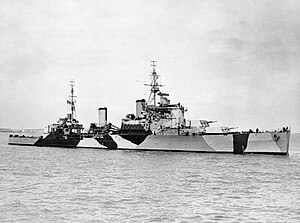
HMS Fiji was the lead ship of her class of 11 light cruisers built for the Royal Navy shortly before the Second World War. Completed in mid-1940, she was initially assigned to the Home Fleet and was detached to escort a force tasked to force French West Africa to join the Free French. The ship was torpedoed en route and required six months to be repaired. Fiji was then assigned to Force H where she helped to escort convoys to Malta. The ship was transferred to the Mediterranean Fleet in early May 1941. After the Germans invaded Crete a few weeks later, she was sunk by German aircraft on 22 May after having fired off all of her anti-aircraft ammunition.

The Fiji-class cruisers were a class of eleven light cruisers of the Royal Navy that saw extensive service throughout the Second World War. Each ship of the class was named after a Crown colony or other constituent territory of the British Commonwealth and Empire. The class was also known as the Colony class, or Crown Colony class. Developed as more compact versions of the preceding Town-class cruisers, the last three were built to a slightly modified design and were sometimes also called the Ceylon class.

HMS Duke of York was a King George V-class battleship of the Royal Navy. Laid down in May 1937, the ship was constructed by John Brown and Company at Clydebank, and commissioned into the Royal Navy on 4 November 1941, subsequently seeing combat service during the Second World War. In mid-December 1941, Duke of York transported Prime Minister Winston Churchill to the United States to meet President Franklin D. Roosevelt. Between March and September 1942 Duke of York was involved with convoy escort duties, including as flagship of the Heavy Covering Force of Convoy PQ-17, but in October she was dispatched to Gibraltar where she became the flagship of Force H.
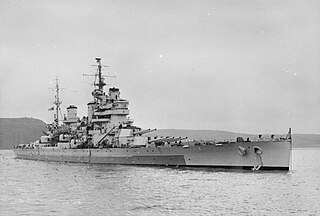
HMS Anson was a King George V-class battleship of the Royal Navy, named after Admiral George Anson. She was built by Swan Hunter and Wigham Richardson Shipyard on the River Tyne and launched on 24 February 1940, being completed on 22 June 1942. Her completion was delayed to allow the fitting of fire-control radar and additional anti-aircraft weapons. She was originally to have been named Jellicoe, but was renamed Anson in February 1940.

HMS Repulse was one of two Renown-class battlecruisers built for the Royal Navy during the First World War. Originally laid down as an improved version of the Revenge-class battleship, her construction was suspended on the outbreak of war because she would not be ready in time. Admiral Lord Fisher, upon becoming First Sea Lord, gained approval for her to resume construction as a battlecruiser that could be built and enter service quickly. The Director of Naval Construction (DNC), Eustace Tennyson-d'Eyncourt, quickly produced an entirely new design to meet Admiral Lord Fisher's requirements and the builders agreed to deliver the ship in 15 months. They did not quite meet that ambitious goal, but the ship was delivered a few months after the Battle of Jutland in 1916. Repulse and her sister ship Renown were the world's fastest capital ships upon completion.

The Battle of the North Cape was a Second World War naval battle that occurred on 26 December 1943, as part of the Arctic campaign. The German battleship Scharnhorst, on an operation to attack Arctic convoys of war materiel from the western Allies to the Soviet Union, was brought to battle and sunk by the Royal Navy's battleship HMS Duke of York with cruisers and destroyers, including an onslaught from the destroyer HNoMS Stord of the exiled Royal Norwegian Navy, off the North Cape, Norway.

HMS Kent, pennant number 54, was a County-class heavy cruiser built for the Royal Navy in the late 1920s. She was the lead ship of the Kent subclass. After completion the ship was sent to the China Station where she remained until the beginning of the Second World War, aside from a major refit in 1937–38. Kent hunted the German pocket battleship Admiral Graf Spee in the East Indies in late 1939 and then was reassigned to troop convoy escort duties in the Indian Ocean in early 1940. She was transferred to the Mediterranean in mid-1940, but was torpedoed shortly after arriving. The ship was under repair for a year and was then assigned to Home Fleet where she escorted convoys to and from North Russia for the next several years. In mid-1944 Kent escorted British aircraft carriers as their aircraft made attacks on German shipping and airfields in Norway. A few months later she was flagship of a force that intercepted a German convoy in Norwegian waters and sank two freighters and five escorts. The ship was paid off in early 1945 and placed in reserve until she was used as a target. Kent was sold for scrap in 1948.

Admiral Hipper was the lead ship of the Admiral Hipper class of heavy cruisers which served with Nazi Germany's Kriegsmarine during World War II. The ship was laid down at the Blohm & Voss shipyard in Hamburg in July 1935 and launched February 1937; Admiral Hipper entered service shortly before the outbreak of war, in April 1939. The ship was named after Admiral Franz von Hipper, commander of the German battlecruiser squadron during the Battle of Jutland in 1916 and later commander-in-chief of the German High Seas Fleet. She was armed with a main battery of eight 20.3 cm (8 in) guns and, although nominally under the 10,000-long-ton (10,160 t) limit set by the Anglo-German Naval Agreement, actually displaced over 16,000 long tons (16,260 t).

Operation Nordseetour was an unsuccessful raid conducted between 30 November and 27 December 1940 by the German heavy cruiser Admiral Hipper. It formed part of the World War II Battle of the Atlantic, with the heavy cruiser seeking to attack Allied convoys in the North Atlantic. Admiral Hipper left Germany on 30 November 1940 and entered the Atlantic after evading British patrols. She had difficulty locating any convoys, and was plagued by engine problems and bad weather. While returning to Brest in German-occupied France, Admiral Hipper encountered Convoy WS 5A on the night of 24 December. A torpedo attack that night did not inflict any damage, and Admiral Hipper was driven off by the convoy's escorts when she attacked on the next morning. Two British transports and a heavy cruiser were damaged. The German cruiser sank a merchant ship later on 25 December, and arrived in Brest on 27 December.

HMS Bonaventure was the lead ship of the Dido-class light cruisers built for the Royal Navy (RN) during the 1930s and during the Second World War. Completed in 1940, Bonaventure was assigned to the Home Fleet and participated in Operation Fish, the evacuation of British wealth from the UK to Canada in July. The ship made one short patrol in August into the North Atlantic to search for German blockade runners and followed that up by escorting an aircraft carrier as it conducted air strikes in Southern Norway in September. The next month she was tasked to provide cover for anti-shipping raids off the Norwegian coast. Bonaventure participated in the unsuccessful search for the German commerce raider Admiral Scheer in November and sustained weather damage that caused her to spend time in a dockyard for repairs. She was part of the escort force for Convoy WS 5A in December and helped to drive off another German commerce raider. While searching for stragglers from the convoy, the cruiser sank a German blockade runner.

HMS Hermione was a Dido-class light cruiser of the Royal Navy. She was built by Alexander Stephen and Sons,, with the keel laid down on 6 October 1937. She was launched on 18 May 1939 and commissioned 25 March 1941. On 16 June 1942, Hermione was torpedoed and sunk by the German submarine U-205 in the Mediterranean. Eighty-eight crewmembers were killed.
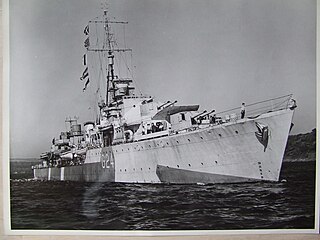
HMCS Huron was a Tribal-class destroyer that served in the Royal Canadian Navy in the Second World War and the Korean War. She was the first ship to bear this name, entering service in 1943. She was named for the Huron people. During the Second World War the vessel saw service in Operation Neptune in the Bay of Biscay and along the French coast in support of the invasion of Normandy and escorted convoys to the Soviet Union. Following the war, the ship was placed in reserve. The destroyer was activated in 1950 as a training ship, but with the onset of the Korean War, was modernized and deployed twice to Korea. Following the war, Huron reverted to a training ship and took part in Cold War-era North Atlantic Treaty Organization (NATO) naval exercises until being paid off for the final time in 1963 and broken up for scrap in 1965.
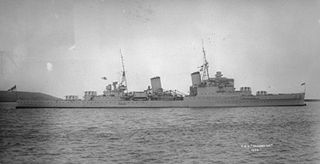
HMS Gloucester was one of the second batch of three Town-class light cruisers built for the Royal Navy during the late 1930s. Commissioned shortly before the start of World War II in August 1939, the ship was initially assigned to the China Station and was transferred to the Indian Ocean and later to South Africa to search for German commerce raiders. She was transferred to the Mediterranean Fleet in mid-1940 and spent much of her time escorting Malta Convoys. Gloucester played minor roles in the Battle of Calabria in 1940 and the Battle of Cape Matapan in 1941. She was sunk by German dive bombers on 22 May 1941 during the Battle of Crete with the loss of 722 men out of a crew of 807. Gloucester acquired the nickname "The Fighting G" after earning five battle honours in less than a year.
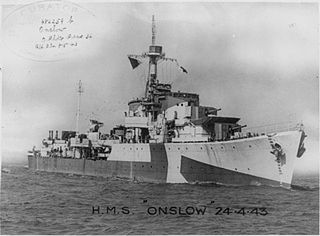
HMS Onslow was an O-class destroyer of the Royal Navy. The O-class were intermediate destroyers, designed before the outbreak of the Second World War to meet likely demands for large number of destroyers. They had a main gun armament of four 4.7 in guns, and had a design speed of 36 kn. Onslow was ordered on 2 October 1939 and was built by John Brown & Company at their Clydebank, Glasgow shipyard, launching on 31 March 1941 and completing on 8 October 1941.
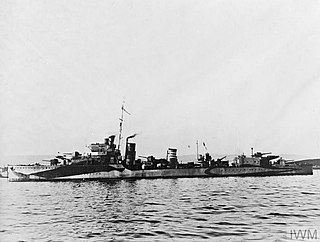
HMS Faulknor was the flotilla leader for the F-class destroyers built for the Royal Navy during the 1930s. The ship had a particularly active operational role during World War II, being awarded 11 battle honours, and was known as "The hardest worked destroyer in the Fleet". She was the first ship to sink a German U-boat, took part in the Norwegian Campaign, served with Force H in the Mediterranean on the Malta Convoys, escorted convoys to Russia and across the Atlantic, and saw action during the invasions of Sicily, Italy and Normandy, and was at the liberation of the Channel Islands. She was then decommissioned and sold for scrap in late 1945.

HMS Forester was one of nine F-class destroyers built for the Royal Navy during the early 1930s. Although assigned to the Home Fleet upon completion, the ship was attached to the Mediterranean Fleet in 1935–36 during the Abyssinia Crisis. A few weeks after the start of World War II in September 1939, she helped to sink one German submarine and then participated in the Second Battle of Narvik during the Norwegian Campaign of 1940. Forester was sent to Gibraltar in mid-1940 and formed part of Force H where she participated in the attack on the Vichy French ships at Mers-el-Kébir and the Battle of Dakar between escorting the aircraft carriers of Force H as they flew off aircraft for Malta and covering convoys resupplying and reinforcing the island until late 1941. During this time the ship helped to sink another German submarine.

Scharnhorst was a German capital ship, alternatively described as a battleship or battlecruiser, of Nazi Germany's Kriegsmarine. She was the lead ship of her class, which included her sister ship Gneisenau. The ship was built at the Kriegsmarinewerft dockyard in Wilhelmshaven; she was laid down on 15 June 1935 and launched a year and four months later on 3 October 1936. Completed in January 1939, the ship was armed with a main battery of nine 28 cm (11 in) C/34 guns in three triple turrets. Plans to replace these weapons with six 38 cm (15 in) SK C/34 guns in twin turrets were never carried out.

Gneisenau was a German capital ship, alternatively described as a battleship and battlecruiser, of Nazi Germany's Kriegsmarine. She was the second vessel of her class, which included her sister ship, Scharnhorst. The ship was built at the Deutsche Werke dockyard in Kiel; she was laid down on 6 May 1935 and launched on 8 December 1936. Completed in May 1938, the ship was armed with a main battery of nine 28 cm (11 in) C/34 guns in three triple turrets. Plans were approved, once construction had started, to replace these weapons with six 38 cm (15 in) SK C/34 guns in twin turrets, but as this would involve a lot of redesign, construction continued with the lower calibre guns. The intent was to make the upgrade in the winter of 1940–41, but the outbreak of World War II stopped this.
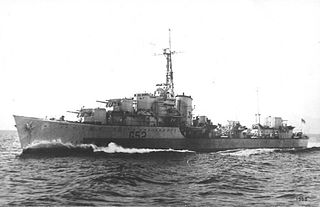
HMS Matchless was a M-class destroyer built during World War II. After the war she was placed in reserve until August 1957 and eventually sold to the Turkish Navy, who renamed her TCG Kılıç Ali Paşa. She was struck from the Turkish Navy list and scrapped in 1971.

Z29 was one of fifteen Type 1936A destroyers built for the Kriegsmarine during World War II. Completed in 1941, she took part in the Channel Dash in early 1942 as flagship of the escort force. Despite this venture to France, the ship spent most of the war in Norwegian waters, escorting German ships and laying minefields. Z29 participated in the indecisive Battle of the Barents Sea at the end of the year, during which she helped to sink a British minesweeper. The ship was damaged during the raid on the island of Spitsbergen in September 1943. Z29 was damaged by British aircraft attacking the battleship Tirpitz in July 1944. The ship escorted troop convoys from northern Norway when the Germans began evacuating the area beginning in October until she began an extensive refit in December.
